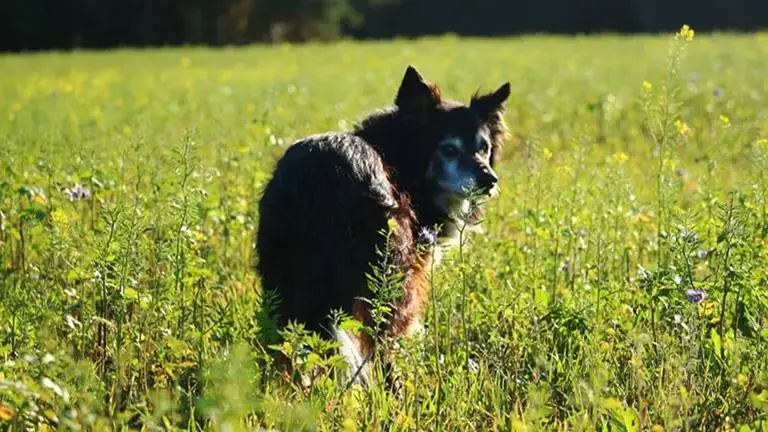Dogs eating dead bees 🐝 may seem odd, but it’s a common occurrence. In this article, we delve into the reasons behind this behavior, its implications for their health, and what pet owners can do to prevent it.
The consumption of dead bees could indicate a lack of proper nutrition, so it’s crucial to uncover the cause. . By taking the necessary measures and educating themselves, pet owners can ensure their dogs’ well-being.
Why Dogs Eat Dead Bees?
Many dog owners have observed their dogs eating dead bees, which can be concerning. However, it’s not uncommon for dogs to eat insects, including bees, and there are a few reasons why dogs eat dead bees.
One reason is that dogs are naturally curious creatures, and they explore their surroundings using their sense of smell and taste. Therefore, when they come across a dead bee, they may be curious and try to investigate it, leading to ingestion.
Another reason why dogs eat dead bees is that bees contain protein, which dogs need for their overall health and well-being. Dogs are omnivores and require a balanced diet that includes protein, carbohydrates, and fats. Although bees are not a staple food in a dog’s diet, they do contain essential amino acids that can be beneficial for dogs.
Like humans, Dogs can also become bored if they lack stimulation and activities to occupy their time. In such cases, eating dead bees can be a way for them to entertain themselves and alleviate boredom. Additionally, for some dogs, eating dead bees may provide a sense of comfort, similar to the way humans engage in comfort eating.
Another reason why dogs eat dead bees is due to their natural hunting instincts. Dogs have a strong prey drive, and they are instinctively drawn to small creatures that move quickly, such as bees. Therefore, when a dog comes across a dead bee, their hunting instincts may kick in, and they may see it as an opportunity to catch and consume their prey. This behavior can be especially prevalent in breeds that were originally bred for hunting, such as terriers and hounds.
Dog Bee Sting Symptoms
If your dog has been stung by a bee, it’s essential to look out for symptoms that may indicate an allergic reaction or other complications. The following are some common dog bee sting symptoms:
- Swelling at the site of the sting
- Hives or welts
- Difficulty breathing
- Rapid heartbeat
- Weakness or collapse
- Vomiting or diarrhea
If any of these signs are present, it is important to take the dog to a veterinarian for a check-up. Additionally, keeping the dog away from any dead bees or honeycomb is advised as the toxins from the dead bees may still be present and be hazardous to the dog’s health.
It is also important to monitor the dog’s water intake, as dogs can become dehydrated more quickly than humans when they are sick and dehydrated dogs may experience vomiting as a symptom.
If dog seem exhausted then offer small, frequent meals of a Bland diet. And if required, consult a veterinarian for further advice on how to manage any distress and/or illness resulting from consuming dead bees.
Dog Bee Sting Treatment
If your dog has been stung by a bee, there are several steps you can take to reduce the severity of the reaction and speed up the recovery time. Here are some helpful tips:
Remove the Stinger
If you can see the bee sting, use a credit card or other flat object to scrape it away from the skin.
Apply a Cold Compress
Place a cold compress, such as a bag of frozen peas or a cold, wet towel, on the site of the sting. This will help to reduce swelling and discomfort.
Benadryl for Dog Bee Sting
Benadryl is an over-the-counter antihistamine that can help to reduce the severity of the reaction. Check with your veterinarian first to ensure the appropriate dosage for your dog’s weight.
Monitor Your Dog
Keep an eye on your dog for the next several hours to ensure that the reaction doesn’t worsen.
Dog Bee Sting Recovery Time
The recovery time for a dog bee sting can vary depending on the severity of the reaction. Mild reactions usually resolve within a few hours, while more severe reactions can take several days to subside. During this time, your dog may feel uncomfortable and irritable. However, with proper care and attention, your dog can recover fully and quickly.
Another useful read: Dog Nose Cut – Home Remedies
How to Prevent Dogs from Eating Bees?
Dogs are susceptible to bee stings, and for some, it can cause a severe allergic reaction. Therefore, it is essential to take preventative measures to avoid any adverse effects of a dog bee sting allergic reaction.
Regularly picking up dead bees and other debris from your yard can reduce the chances of your dog coming across a dead bee and ingesting it, which can lead to a bee sting.
Additionally, securing your trash cans and training your dog not to eat or chew on things that don’t belong to them can prevent your dog from consuming bees and other insects. Limiting your dog’s access to areas where bees congregate, such as flowering plants and trees, can also reduce their chances of being stung.
Furthermore, keeping insect bait away from your dog’s reach is another way to prevent them from ingesting bees that may have been poisoned by the bait.
It is essential to recognize the signs of a allergic reaction, such as hives, swelling, and difficulty breathing, and seek veterinary care immediately if you suspect that your dog has been stung. In some cases, a dog bee sting allergic reaction can lead to anaphylaxis, a life-threatening condition.
By taking the necessary precautions and seeking prompt veterinary care, you can protect your dog from the dangers of bee stings and ensure their overall health and well-being.
My dog ate a bee and got stung in the mouth – what should I do?
Next, you should apply a cold compress to the affected area to help reduce swelling. You can use a bag of frozen peas or a cold, wet cloth. It’s also a good idea to give your dog a small amount of Benadryl to help reduce any allergic reactions.
If your dog is showing signs of difficulty breathing or swallowing, you should seek veterinary care immediately. These symptoms can be life-threatening and require immediate attention.


